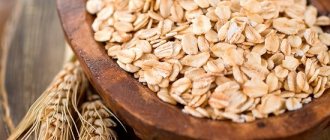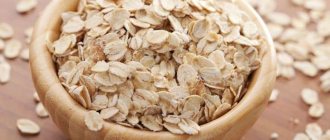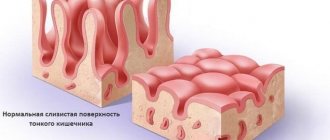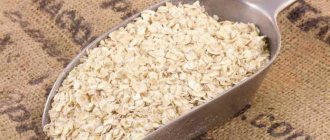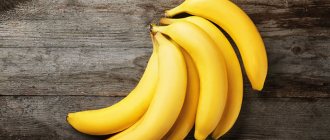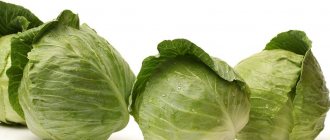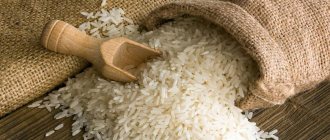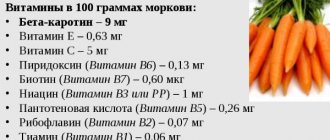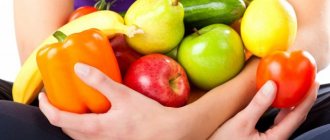Diet therapy for diabetes mellitus (DM) involves limiting the calorie content of dishes and reducing the GI of foods. Most cereal porridges meet these requirements. Their benefits for diabetics are obvious. Hearty, nutritious, they satisfy the feeling of hunger for a long time, and are sources of carbohydrates necessary for the body. Are all cereals healthy, what cereals are suitable for type 2 diabetes, every patient should know this.
Which index is safe for diabetes?
Indicators are calculated on a scale from 0 to 100 units or points:
- low GI – from 0 to 40;
- average – from 40 to 60;
- high – 60-100.
The GI index is affected by the carbohydrate content of the product. If food contains simple (fast) carbohydrates, it provokes a sharp rise in blood sugar. Complex carbohydrates, on the contrary, provide a smooth increase in sugar and optimal insulin release.
For a person with diabetes, it is important that blood glucose rises smoothly. Therefore, products with low GI (less than 40 units) are preferred. Products with an average GI (40-60 units) are allowed only in limited quantities. That is why, when choosing which cereals are suitable for type 2 diabetes, you should take into account their GI.
How does GI affect the diabetic body?
The indicator under consideration is not a constant and unchangeable value.
The index is formed from several indicators:
- chemical composition of the product;
- method of heat treatment (cooking, stewing);
- amount of fiber;
- content of indigestible fiber.
Example: brown rice index - 50 units, peeled rice - 70 units.
This value is also influenced by factors such as:
- endemic;
- variety;
- botanical features of the species;
- ripeness.
The effect on the human body of different products is different - the higher the index, the more sugar will enter the blood during the digestion and breakdown of fiber.
An indicator equal to 0-39 units is considered safe - such cereals can be consumed in the diet with virtually no restrictions.
The average is 40-69 units, so such products should be included in the diet in limited quantities. If the indicator is 70 or higher, then such cereals can be used in the daily menu only after consultation with a specialist.
What grains are recommended for type 2 diabetes?
Many cereals contain complex carbohydrates, which are valuable for a balanced diet. Porridges allowed for type 2 diabetes mellitus can be cooked from the following grains:
- barley (pearl barley, barley);
- oats (oatmeal, rolled oats);
- buckwheat (buckwheat);
- millet (millet).
If well tolerated, diabetics can cook side dishes from peas, lentils and other legumes. All of these foods have a low GI.
Considering the calorie content of grains and the presence of starch in them, you should not get carried away with them too much. It is allowed to consume no more than 1 serving per day, preferably in the first half of the day, in order to be able to adequately consume the calories received.
The usefulness of porridge also depends on the method of processing the cereal and its preparation. Which cereals are useful for type 2 diabetes should be considered separately.
Barley
Two types of cereals are obtained from barley grain - pearl barley (this is a whole, but ground and polished grain) and barley (crushed grain). Barley grains contain about 87% starch, which is why they take a long time to cook.
It has been noted that the GI of viscous (thick) cereals is higher than that of semi-liquid ones. Adding milk or butter to pearl barley or barley porridge is undesirable for type 2 diabetes, as this also increases the glycemic index.
Table 1. Dependence of GI on the method of processing and preparation of cereals
| Groats | Processing method | Glycemic index |
| Barley | Milk pearl barley | 50 |
| Barley on the water | 22 | |
| Barley milk | 50 | |
| Barley on the water | 35 |
Minimum GI for pearl barley in water. Thanks to this, pearl barley porridge for type 2 diabetes will help reduce weight, the excess of which diabetics often suffer from.
The high level of fiber in barley cereals helps improve sensitivity to insulin, normalize fat and other metabolic processes.
Oatmeal
Crushed, uncrushed, rolled groats and flakes are obtained from oats. Experts in therapeutic diets believe that for type 2 diabetes, oatmeal should be cooked from whole grains or large flakes. The coarser the grain is ground, the more fiber it contains, which is necessary to normalize metabolism.
Table 2.
| Groats | Processing method | Glycemic index |
| Oatmeal | Uncrushed | 35 |
| Flattened grain | 40 | |
| Instant cereal | 66 | |
| Oatmeal with milk | 60 | |
| Oatmeal on the water | 40 |
Oatmeal is rich in easily digestible proteins and fats, complex carbohydrates, amino acids, and B vitamins, so it is a healthy dish in a diabetic’s diet.
Buckwheat
Buckwheat is rich in complex carbohydrates, causes a prolonged feeling of fullness, and promotes a slow increase in blood sugar. Buckwheat porridge for type 2 diabetes should be boiled in water. The GI of crumbly porridge is higher than that of semi-liquid porridge. The value of buckwheat for patients with diabetes lies in its rich and balanced mineral and vitamin composition (100 g contains 50% of the daily requirement of iron, there are other macroelements).
Calorie content is 343 kcal per 100 g, protein content - 12.6 g, fat - 2.6 g, carbohydrates - 68 g.
Buckwheat has an average GI of 50, so it can be eaten no more than 1-2 times a week.
Millet
Despite the high caloric content and amount of carbohydrates, millet porridge is allowed for type 2 diabetes. It is rich in vitamins B and PP, amino acids, omega-6 polyunsaturated fatty acids, and fiber.
Table 3.
| Groats | Processing method | Glycemic index |
| Millet | Polished grain | 71 |
| Milk millet | 71 | |
| Millet on the water | 50 |
Due to its high calorie content and GI, millet porridge can appear on a diabetic’s menu no more than once a week. It contains oxalic acid, which is why it is contraindicated for people with stomach and intestinal ulcers.
Properties and calorie content of cooked cereals (table)
Since cereal absorbs water during cooking, 100 g of any ready-made porridge contains significantly more of the latter (6-8 times) and significantly less nutrients (3-5 times). For this reason, al dente porridges prepared with a small amount of water are much healthier than boiled ones. In a 100 g serving they contain more fiber, vitamins and minerals, although correspondingly more calories.
Our latest table compares some cereals in their already cooked form. All of these cereals are high in beneficial microelements, in particular quinoa, bulgur and wild rice. Have you already introduced them into your diet?
Bulgur grains are also very useful when boiled.
What cereals are prohibited?
People who monitor their blood sugar levels should remember which cereals they should not eat if they have type 2 diabetes:
- from all types of wheat cereals, including semolina;
- any instant cereals (muesli, small grain flakes);
- from white rice.
The glycemic index of white milled rice is 70 units, parboiled rice is 60, and milk rice porridge is 70. Rice has lower calorie content than other cereals, but it has little plant fiber, a lot of starch, and its sugar level quickly rises. You can replace white rice with other varieties - brown, brown, wild.
Wheat
Wheat cereal has long been known for its concentration of fiber, which prevents the formation of fat by regulating blood glucose levels. In addition, it contains pectins, which prevent rotting from starting and improve the general condition of the mucous membrane of the gastrointestinal tract. As for the glycemic index, wheat cereal has an index of 45.
When compiling a diet, you should always focus on the glycemic index of cereals, since many processes, including digestion, depend on it, and for some diseases this indicator is key.
What do you eat them with?
It is also important what to combine the permitted side dishes with. For diabetes, these should be foods rich in fiber that can lower the GI:
- fresh herbs;
- salads from raw vegetables (without mayonnaise);
- mild, unsweetened and low-fat sauces.
Your doctor can recommend a recipe for a healthy salad or addition to your porridge. The patient’s task is to eat fractionally (small portions, but often), monitor blood sugar levels and follow other recommendations of the endocrinologist.
Healthy recipes
If you have diabetes, it is better to cook any cereal, including buckwheat, in water, without adding butter. If you decide to cook porridge with milk, then it is better to stick to the proportions of one to one, that is, mix milk and water in equal quantities.
You can also prepare complex side dishes from buckwheat, for example, by stewing it with mushrooms, vegetables, meat or offal (liver, beef tongue).
Buckwheat is used not only as side dishes, but also to create flour dishes. Buckwheat flour makes baked goods quite tasty and unusual in taste. Pancakes are also made from it.
You can prepare the following dishes from buckwheat:
- boiled porridge with water or milk;
- buckwheat with mushrooms;
- buckwheat with vegetables;
- various buckwheat pastries.
The recipe for buckwheat pancakes is quite simple to prepare. The following ingredients will be required:
- one egg;
- crumbly cottage cheese – 100 grams;
- baking powder – 0.5 teaspoon;
- stevia – 2 sachets;
- boiling water – 300 ml;
- vegetable oil – 1.5 tablespoons;
- salt - on the tip of the knife;
- buckwheat flour – 200 grams.
To begin with, you should pour boiling water over the filter bags of stevia and leave for 15–20 minutes, cool the water and use it for cooking. Separately mix stevia, cottage cheese and egg. Sift the flour through a sieve and mix with salt and baking powder, pour in the curd mixture, add vegetable oil. Fry without adding oil, preferably in a Teflon-coated pan.
You can make buckwheat pancakes with berry filling. The second recipe is identical to the first, only at the last stage of kneading the dough you need to add berries. For diabetes, the following are allowed:
- black and red currants;
- blueberry.
An equally popular baked product for type 2 diabetics is buckwheat cookies. It can be consumed for breakfast, or as an addition to lunch. Just take into account how much XE is contained in such cookies. This pastry contains only 0.5 XE per 100 gram serving.
Required:
- sweetener - to taste;
- buckwheat flour – 250 grams;
- egg – 1 pc.;
- low-fat margarine – 150 grams;
- cinnamon - to taste;
- salt on the tip of a knife.
Mix soft margarine with egg, salt and sweetener, mix everything thoroughly. Add flour in parts, knead into a tight dough. Roll out the dough and form cookies. Bake in a preheated oven at 180 C for 25 minutes.
This type of baking is suitable for any type of diabetes and will not affect blood sugar levels.
Oatmeal
Due to the flattening of the grains during production, oats have ceased to be a useful product. The value of the flakes varies depending on preparation and processing. The glycemic index of whole grain oatmeal is 58, and instant porridge from a bag is 83.
Milling oats and wheat leads to a decrease in the amount of fiber; as a result, the cereal raises glucose levels after eating. You need to buy minimally processed oatmeal, which is cooked for 40-60 minutes. Oats contain soluble and insoluble fiber. In the intestines, grains absorb moisture and slowly pass through the digestive tract, ensuring satiety.
Glycemic index of confectionery products
| Pancakes | 70 |
| Pancakes made from premium flour | 69 |
| Wheat bagel | 72 |
| Bulgur | 48 |
| Hot dog bun | 92 |
| Butter bun | 88 |
| Hamburger buns | 61 |
| French buns | 95 |
| Chinese vermicelli | 35 |
| Fried white croutons | 100 |
| Crackers | 80 |
| Cream with added wheat flour | 66 |
| Croissant | 67 |
| Instant noodles (vermicelli) | 65 |
| Wholemeal noodles | 45 |
| Rice noodles | 92 |
| Unleavened flatbread | 69 |
| Pasta | 60 |
| Premium pasta | 85 |
| Wholemeal pasta | 38 |
| Durum wheat pasta | 50 |
| Pasta with cheese | 64 |
| Whole soy flour | 15 |
| Muesli | 80 |
| Muesli with nuts and raisins | 80 |
| Swiss muesli | 66 |
| Pies, sponge cake | 55 |
| Pies | 59 |
| Sponge cake | 75 |
| Custard cake with cream | 75 |
| Shortcake | 75 |
| Puff pastry with cream | 75 |
| Fried pie with jam | 88 |
| Baked pie with onion and egg | 88 |
| Meat pie | 50 |
| Pita Arabian | 57 |
| Pizza with tomatoes and cheese | 60 |
| Donuts | 76 |
| Gingerbread | 65 |
| Wheat flour (grade) | 70 |
| Wheat bread made from premium flour | 50 |
| Wheat bread with bran | 50 |
| Rye bread | 50 |
| Rye bread with bran | 40 |
| Rice flour | 95 |
| Ordinary baking | 85 |
| Soy flour, defatted | 15 |
| Soy bread | 15 |
| Wholemeal spaghetti | 38 |
| Crackers | 50 |
| Crackers | 74 |
| Simple dryers | 50 |
| Yeast dough | 55 |
| Puff pastry | 55 |
| Bread "Borodinsky" | 45 |
| White bread | 85 |
| White bread (loaf) | 136 |
| French long bread | 75 |
| Wheat grain bread, rye bread | 40 |
| Bread made from premium flour | 80 |
| Wholemeal bread | 60 |
| Wheat bread made from premium flour | 65 |
| Rye bread | 50 |
| Rice bread | 85 |
| Bran bread | 45 |
| Fruit bread | 47 |
| Black bread | 65 |
| Bread, pancakes made from buckwheat flour | 50 |
| Wheat bread | 75 |
| Whole grain bread | 45 |
| Germ flakes | 53 |
| Biscuit | 63 |
| Jam | 70 |
| Fruit and berry jam | 55 |
| Waffles | 80 |
| Unsweetened waffles | 76 |
| Waffles with fruit fillings | 65 |
| Dark chocolate (with cocoa content more than 60%) | 25 |
| Jam, preserves | 55 |
| Marshmallow, marshmallow | 65 |
| Caramel with fruit filling | 60 |
| Caramel, lollipops | 80 |
| Chocolate candies | 50 |
| M{amp}amp;Ms | 46 |
| Marmalade | 30 |
| Jelly marmalade | 60 |
| Berry marmalade without sugar, jam without sugar | 30 |
| Marmalade with sugar | 70 |
| Mars, Snickers (bars) | 70 |
| Honey | 90 |
| Ice cream, cream, chocolate, popsicle (high fat) | 60 |
| Sand baskets with fruits | 65 |
| Biscuits | 50 |
| Cookie cracker | 80 |
| Oatmeal cookies | 55 |
| Shortbread cookies | 64 |
| Simple sweet cookies | 55 |
| Sugar | 70 |
| Sucrose | 60 |
| Twix | 62 |
| Fruit chips in sugar | 70 |
| Fructose | 20 |
| Halva | 70 |
| Chocolate "Mars" | 70 |
| Bitter chocolate (cocoa more than 60%) | 25 |
| Milk chocolate | 70 |
| dark chocolate (70% cocoa) | 22 |
| Chocolate bars | 70 |
| Sherbet | 50 |
| Eskimo | 60 |
Recommendations for reducing the indicator
The possibility of obtaining a dietary dish is associated with its proper preparation. If you pursue the goal of consuming a product with a low GI value, you should adhere to the following recommendations:
- Avoid adding milk and granulated sugar with a high glycemic index to porridge, as this creates a high glycemic load;
- use natural sweeteners for porridges;
- when adding fats, give preference to vegetable oils;
- remember that unpolished cereals, as well as coarse cereals, break down more slowly than products that have undergone preliminary mechanical processing (cleaning, grinding);
- If possible, limit or completely eliminate high GI foods from the diet;
- Use a double boiler when cooking cereals.
To learn how to use the glycemic index table, watch the following video.
If you find an error, please select a piece of text and press Ctrl+Enter.
Food with a low glycemic index: daily diet, sample menu, basic rules
Your daily diet should include foods with a low and medium glycemic index, proteins and fats. A low-glycemic diet is necessary for anyone seeking to lose extra pounds or suffering from a predisposition to excess weight.
The principles of such nutrition must be adhered to by all patients at risk for diabetes (with a family history, insulin resistance), with diseases of the cardiovascular, digestive, urinary systems, and endocrine pathologies.
The approximate weekly diet is as follows:
- Monday. Breakfast: boiled meat, fresh vegetables, coffee or tea without sugar. Second breakfast: apple and carrot salad. Lunch: vegetarian soup, fruit or juice for dessert. Afternoon snack: a glass of low-fat and unsweetened yogurt, rosehip decoction or juice. Dinner: boiled fish with green peas.
- Tuesday. Breakfast: steam omelette with vegetables. Second breakfast: low-fat cottage cheese. Lunch: mushroom or vegetable soup with boiled chicken fillet. Afternoon snack: several fruits, kefir. Dinner: Peppers stuffed with chicken or ground turkey without sauce.
- Wednesday. Breakfast: oatmeal, vegetable salad with vegetable oil and herbs. Second breakfast: apples, a few pieces of dried apricots. Lunch: borscht in non-concentrated chicken or beef broth, fresh or sauerkraut salad. Afternoon snack: low-fat cottage cheese, you can add berries. Dinner: baked fish, buckwheat porridge.
- Thursday. Breakfast: omelet, carrot salad with apple. Second breakfast: yogurt. Lunch: fish soup without rice, boiled fish with peas. Afternoon snack: a glass of kefir, a handful of dried fruits. Dinner: whole grain porridge, boiled fillet, some fresh vegetables.
- Friday: Breakfast: rolled oats, boiled eggs. Second breakfast: low-fat cottage cheese. Lunch: lean soup, boiled meat with vegetables. Afternoon snack: fruit. Dinner: boiled hake fillet, boiled unpolished rice.
- Saturday: Vegetable salad with low-fat cheese, whole grain toast. Second breakfast: fruit or juice. Lunch: mushroom soup, boiled meat, stewed vegetables. Afternoon snack: yogurt. Dinner: salad of seafood, herbs and vegetables.
- Sunday: Breakfast: any porridge, 2 egg whites. Second breakfast: seasonal fruits, yogurt. Lunch: lean vegetable soup, boiled fish, vegetables in any form. Afternoon snack: a handful of dried fruits. Dinner: buckwheat, baked turkey fillet.
You can choose your own menu and recipes.
- avoid eating foods with high GI;
- maximum content of slowly digestible carbohydrates in the diet;
- do not add sugar to coffee and tea, completely eliminate sweet and carbonated drinks;
- give up quick snacks - you must strictly follow the established diet;
- take bottled yogurt or kefir with you on long walks to prevent feelings of hunger and subsequent overeating;
- Cooking dishes must be steamed, boiled or stewed with a minimum of oil.
After just a few weeks of following a low-glycemic diet, excess weight gradually begins to disappear, vigor appears, and overall well-being improves. Physical activity is easier to bear, shortness of breath, tachycardia, and hypertension disappear. The craving for sweets and junk food gradually decreases, and the tendency to overeat disappears.
Compared to fairly “extreme” diets, the principles of low-glycemic nutrition have their advantages:
- variety of permitted products;
- wide scope for imagination and creation of new recipes;
- frequent meals that do not cause feelings of hunger;
- affordable price;
- Suitable for almost all family members.
To successfully stick to a diet, foods with a low glycemic index should not be monotonous. The main thing is to get rid of psychological dependence on tasty but unhealthy food.
However, almost everyone from time to time has the desire to try the “forbidden fruit” - something sweet, very unhealthy and fatty. To prevent a breakdown in your diet, you can treat yourself to candy, a small piece of cake or chocolate for second breakfast once a week (for example, on a weekend).
Indicators of quantities
There are the following numerical values for assessing the level of the indicator:
- if the indicator is between zero and thirty-nine, it is considered low;
- the average ranges from forty to sixty-nine;
- a high level of the indicator is indicated by a value that exceeds seventy.
For those suffering from diabetes, as well as for people on diets, reference tables are prepared. Using them you can obtain information about the GI of a particular product. Below is a version of the table, which contains information about the GI of the most common cereals. The values are arranged in ascending order starting with the grain with the lowest GI. This is followed by the names of products, the indicator of which gradually increases.
The ranking is completed by the cereal with the highest GI index:
- rice bran – 19;
- pea cereal – 22;
- pearl barley – 20-30;
- flaxseed – 35;
- spelled – 40;
- bulgur – 45;
- whole oatmeal – 45-50;
- barley grits – 50-60;
- crushed oatmeal – 55-60;
- brown rice – 55-60;
- buckwheat – 50-65;
- couscous – 65;
- white rice – 65-70;
- corn grits – 70-75;
- muesli – 80;
- semolina – 80-85.
Buckwheat
Buckwheat is in demand among those who have set a goal to eat healthy or have decided to lose a few extra pounds. Nutritionists recommend including this product in the diet for those who want to become slim. The trick is that the GI of raw buckwheat is 55, and for cooked cereal this figure is 15 units less, that is, 40. The index value thus changes due to the presence of water in the dish. An important point is the fact that a decrease in the glycemic index does not lead to the loss of vitamins, protein, minerals, and antioxidants.
It is important to remember that when cooking in water (the process of preparing porridge or a side dish from cereals in any case involves this stage), the index will decrease. It’s another matter if a dairy component or granulated sugar is added to the dish: in this case, the product will have an increased glycemic index.
It is not recommended to eat buckwheat porridge with ingredients that are rich in carbohydrates. The best option is to combine buckwheat with chicken and lean fish. It is not advisable to cook buckwheat dishes for dinner due to the presence of the same carbohydrates.
As can be seen from the table above, the highest indicator is inherent in white rice. It is cleaned and polished. Its GI is 65 units. Whereas in brown rice (which is unrefined and not polished), the indicator is 10 units less and is 55. Based on this, we can conclude that brown rice is more healthy than white rice. It contains fewer calories, is rich in macroelements and microelements, amino acids, vitamins B and E. Its only drawback is its short shelf life.
Oatmeal
Everyone has heard about the benefits of this product. As for the GI of oatmeal, this factor is influenced by the method of preparation.
If the porridge is cooked in water, the index will be 40. If milk is used, the index will be higher - 60. And if, in addition to milk, you add sugar, the index will reach 65.
GI of raw oatmeal is 40. The highest level of indicator is inherent in products like muesli and instant porridges. They are, as a rule, thoroughly supplemented with ingredients in the form of sugar, dried fruits, nuts, and seeds. For such food products, the GI index is 80. Therefore, nutritionists recommend not including them in the diet of both diabetics and those who strive to organize a healthy diet.
How to cook bulgur correctly
Boiled grains are the healthiest for the body. They are low in calories and contain the most nutrients. To make the dish tasty, it must be prepared according to the following rules:
- Cook the cereal in water or milk.
- The ratio of grains and liquid should be 1:2.
- Soaking is not necessary. If you want the dish to be crumbly, you should not soak the cereal.
- Bulgur is not washed before cooking: the grains have already been processed and dried.
Bulgur goes well with a variety of foods. It can be eaten with steamed dried fruits. The cereal goes well with pork, fish, vegetables, and is used to stuff tomatoes and peppers. Porridge is used as an addition to salads and soups.
It is better to eat bulgur in the first half of the day. It contains complex carbohydrates that digest slowly and provide the body with energy for half a day. It is better not to eat porridge in the evening: despite its low calorie content, carbohydrates will be stored as fat.
Buckwheat
Cereals are quite popular among those who decide to eat healthy. There are even a number of specially designed diets based on porridge in combination with vegetables and lean meats.
An interesting point is that the GIs of raw and cooked cereals are in different categories:
- raw buckwheat – 55,
- boiled cereal – 40.
The composition and content of nutrients does not change, but the index values vary due to the presence of water in the boiled dish.
The product belongs to the middle group. Adding milk or sugar already shows completely different results, transferring the cereal to the category of cereals with a high glycemic index. A quarter of 100 g of buckwheat consists of carbohydrates, which means you should refrain from eating it for dinner and combining it with other carbohydrate foods. It is better to combine with vegetables and add proteins in the form of fish and chicken.
Corn
Despite the abundance of vitamins and microelements in corn, not everyone can consume it and only in small portions. For such a reason as the high glycemic index, because corn grits have 70 units. In addition, if it is further processed, for example, thermally or chemically, then the GI will increase even more, because in the same corn flakes and popcorn it reaches 85. For this reason, corn products can be consumed, but in small quantities and preferably for non-diabetics .
Metabolic disorders from high GI foods
Energy obtained from carbohydrates is consumed in three ways:
- to replenish expended energy;
- for glycogen reserves in muscles;
- for backup needs in case of energy shortage.
- Storage reservoirs are fat cells located throughout the body. By consuming foods with a high glycemic index, the body is filled with glucose, which is quickly converted into fat. If at the moment the energy is not in demand, the person is sitting or lying down, then this fat is sent for storage in the depot.
Are foods with high GI harmful?
- With constant consumption of foods with a high GI, the level of glucose in the blood constantly remains at an elevated level. Eating something sweet or high-calorie every half hour or hour, even if only a glass of tea with sugar, candy, cookies, buns or sweet fruit, your sugar level will accumulate and rise.
- The body responds to this by reducing insulin production. A metabolic disorder occurs, which is expressed in the accumulation of extra pounds. The fact is that with a lack of insulin, glucose cannot enter the muscle fibers, even if the body needs it at the moment.
- Reserves of unspent energy are sent for storage, deposited in the form of folds on the stomach, sides and thighs.
- With this seemingly constant overeating, a person feels constant hunger and weakness, trying to get energy, he eats more and more. The stomach becomes overstretched, but saturation does not come.
Conclusion:
It is not the high GI foods themselves that are harmful, but their excessive and uncontrolled consumption. If you have worked hard, or spent a couple of hours in the gym, then a high GI will help restore energy and give you a surge of vigor. If you eat these foods in front of the TV at night, then fat deposits will grow by leaps and bounds.
Are Low Glycemic Index Foods Really Healthy?
Products with slow carbohydrates are good because they gradually maintain energy at the desired level. By using them, you will not get bursts of energy, but you will be able to spend it effectively throughout the day. Such products include:
- most vegetables;
- durum pasta (el dente, i.e. slightly undercooked) and brown rice, many legumes;
- fresh fruits, milk and dairy products, dark chocolate, etc.
The glycemic index and calorie content are not related, so it is necessary to understand both concepts. Any product, even one with a low GI, still contains calories.
Here's what nutritionist Kovalkov says about the glycemic index:
Glycemic index of popular dishes
| Vegetarian borscht, cabbage soup | 30 |
| Vareniki | 55 |
| Dumplings with potatoes | 66 |
| Dumplings with cottage cheese | 60 |
| Hamburger (1 piece) | 103 |
| Vegetable cabbage rolls | 55 |
| Low-fat cottage cheese casserole | 70 |
| Half-fat cottage cheese casserole | 65 |
| Potato casserole | 90 |
| Mamalyga (corn flour porridge) | 40 |
| Pancakes | 70 |
| Wheat flour pancakes | 62 |
| Omelette | 49 |
| Dumplings | 55 |
| Dumplings ravioli | 70 |
| Vegetable stew | 55 |
| Sausages | 28 |
| Tomato soup | 52 |
| Lima bean soup | 36 |
| Yellow pea soup | 60 |
| Green dry pea soup | 66 |
| Black Bean Soup | 64 |
| Lentil soup | 44 |
| Syrniki | 70 |
| Cheesecakes made from low-fat cottage cheese | 70 |
| Cheesecakes made from half-fat cottage cheese | 65 |
| Cottage cheese pancakes | 70 |
| Tortellini with cheese | 50 |
| Corn tortillas | 100 |
| White bread toast | 100 |
| Hot Dog | 90 |
| Shawarma in lavash | 70 |
| Egg | 48 |
| White of one egg | 48 |
| Yolk of one egg | 50 |
| Beef Stroganoff | 50 |
| Boiled sausage | 34 |
| Fried beef liver | 50 |
| Cutlet | 40 |
| Breaded cutlet | 50 |
| Chopped cutlets | 50 |
| Crab sticks | 40 |
| Fish fingers | 40 |
| Boiled crayfish | 5 |
Access is limited by court decision or on other grounds established by the legislation of the Russian Federation.
A network address that allows you to identify a site on the Internet is included in the Unified Register of domain names, page indexes of Internet sites and network addresses that allow you to identify sites on the Internet containing information the distribution of which is prohibited in the Russian Federation.
A network address that allows you to identify a site on the Internet is included in the Register of domain names, indexes of pages of sites on the Internet and network addresses that allow you to identify sites on the Internet containing information distributed in violation of exclusive rights.
The calorie content and glycemic index of cereals make them accessible to diabetics. However, not all cereals are healthy. Before consumption, you need to find out the most useful way to process cereals, how to cook them correctly and what dishes you should avoid. At first, it is better to check the glycemic index with the table.
Oatmeal: which one is better to choose?
Oatmeal on an industrial scale is produced in 2 versions:
- quick cooking (you don’t need to cook it, just pour boiling water over it for a few minutes);
- classic, requiring cooking.
From the point of view of benefits for the body and fiber content, porridge that needs to be boiled definitely wins, since its grains are not subject to significant processing, and, accordingly, retain the maximum of valuable properties. Uncooked oatmeal also contains vitamins, minerals and healthy carbohydrates, but has a higher glycemic index (about 60) than traditionally cooked cereals with water (40-45). You should not indulge in such cereals if you have diabetes, although frequent consumption of any oatmeal is not recommended even for healthy people due to its ability to “flush” calcium from the body.
Instant oatmeal is a thin oatmeal that is already steamed so it doesn't need to be cooked.
